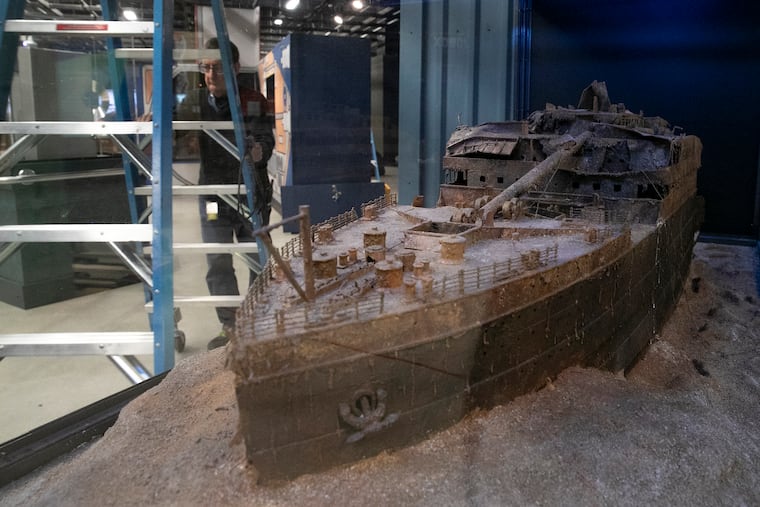See bony-eared assfish and other deep-sea life in the Academy of Natural Sciences’ new exhibit
Cold, lightless world of deepest ocean reveals weird creatures and human ingenuity in exploration.

Light completely disappears from the ocean after a mere 1,000 meters.
The water is cold down there, too, maybe 38 to 39 degrees.
And the weight of the water on any creature at the very bottom is the equivalent of 1,600 elephants on the top of a small car, according to the Woods Hole Oceanographic Institution.
That’s a lot of elephants for a small car.
But not too many for the bony-eared assfish, the ratfish ghostie, the giant tube worm, or some other less-than-glamorous sounding fish who will be taking a star turn in “Extreme Deep: Mission to the Abyss,” the exhibition going up at the Academy of Natural Sciences on April 2 for a run through July 24.
“For years, scientists thought that there were no creatures that could possibly withstand that kind of deep pressure,” said Jennifer Sontchi, the academy’s senior director of exhibitions and public spaces, talking about the briny deep. “Since then, that’s been found to be not at all true.”
In fact, the exact opposite seems to be the case. According to a recent study of DNA from deep-sea sediments, British scientists determined that there is at least three times more life on the seafloor than there is higher up in the ocean, and that two-thirds of that life has not yet even been identified.
Almost seven miles deep
The extreme deep ocean, which reaches depths of about 11,000 meters at the southern end of the Mariana Trench southwest of Guam, is full of all kinds of creatures.
How deep is 11,000 meters, or 36,089 feet? Mount Everest, the highest point on earth, is only about 29,000 feet above sea level.
The exhibit reveals both the creatures that are down there and how they were discovered, said Sontchi.
“It’s a fascinating look at the animals that do live in this incredibly deep, sun-free part of the world,” she said. “There’s no sun at all. There’s no light. There’s no light of any kind. And you know, it’s barely freezing. It’s like just above freezing temperatures. And, I mean, it’s like you can hardly imagine a more hostile environment.”
Here is where the ratfish is king and assfish is legion. It is, said Sontchi, “a whole other world, a whole other ecosystem, numerous ecosystems that are thriving in these hostile conditions, hostile to humans.”
The assfish is not at all tanklike, armored to withstand the immense pressure of life down there. In fact, it seems a delicate little creature, and probably a little slow-witted. (Some scientists believe the bony-eared assfish has the smallest brain-to-body-weight ratio of all vertebrates on the planet.)
Sontchi said “this little guy” is roughly five and a half inches long. It lives, she said, between a depth of 3,840 feet and 14,500 feet. How can it possibly withstand the weight of all those elephants piling up?
Mark Sabaj, the academy’s collection manager of fishes, said that “outside of its environment” the bony-eared assfish “certainly looks delicate.”
But that 4,500 meters down, where the fish lives is “an extreme environment.”
“It’s dark, it’s under a great deal of pressure, and so in that environment, it’s pretty robust,” Sabaj said.
An interactive way to explore the depths
“Extreme Deep” renders this mysterious realm full of recently discovered, little-seen life-forms and hot thermal vents as vividly as possible. The exhibit also offers close-up views of deep-sea research submersibles as well as shipwrecks — including the Titanic — that pock the ocean floor. And visitors can even operate a replica of a submersible.
Those vessels make it possible to see bizarre creatures like the bony-eared assfish, which is actually a kind of antiarmor fish. “Its body itself is kind of like the consistency of jello, with maybe some harder bones on the inside,” said Sabaj. “Under extreme pressure that’s the best way to live, that’s the form you want to take.”
When the fish is brought to a less hostile environment on the surface, with less water pressure, its cells expand, leaving the fish, in essence, a puddle.
The ratfish, a cousin of the shark, lives primarily off New Zealand and Australia, said Sabaj.
“They call them ghosties,” he said. “These are large fishes with huge heads and big pectoral fins. But where sharks are more in superficial waters. These [ratfish] inhabit the depths, the dark waters. A lot of times they have big eyes.”
Unlike sharks, ratfish have no teeth. They utilize crushing plates to consume mollusks and crustaceans from the ocean bottom.
“There’s not a lot known about them,” said Sabaj. “They’re pretty amazing because they do get pretty large and they do get commercially fished a bit. I’ve seen them in markets but I’ve never tried to taste one.”
While the ratfish can be found in shallower waters, they are largely caught by commercial fishing operations that go deeper and deeper.
“They’re putting their nets longer and deeper to make up for the loss of fish near the surface,” said Sabaj, describing commercial fishing that can capture deepwater fish. “Fishermen are really good at what they do. They’re too good at what they do. They’re always looking for new areas to fish, the deeper water fisheries are becoming more common.”
Scientists exploring the deepest parts of the ocean are also becoming better at what they do. And “Extreme Deep” takes a look at “the science and technology of exploring this space.”
The deep ocean is the least explored part of the planet by far, Sontchi said. And because of its extreme environment, scientists have employed greater and greater ingenuity to go where they believe they need to go. Submersibles and remote operating vehicles, or ROVs, are in states of continuous development. Why?
Because, said Sontchi, “There really are incredible mysteries that we haven’t the foggiest idea about.”